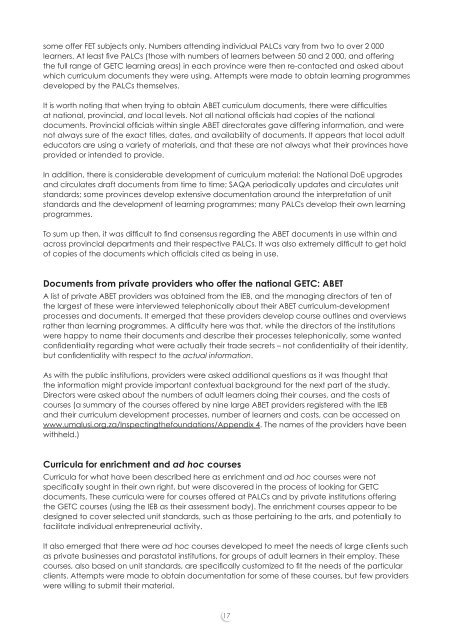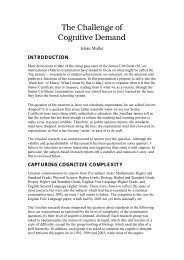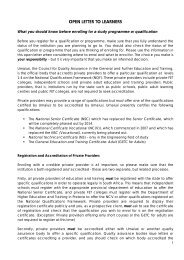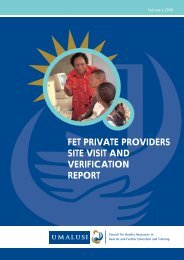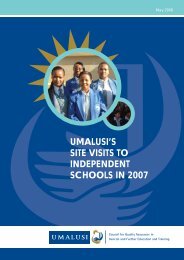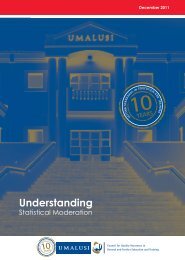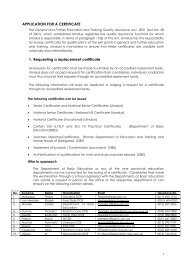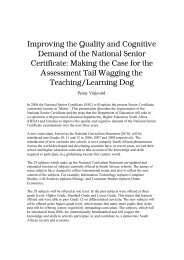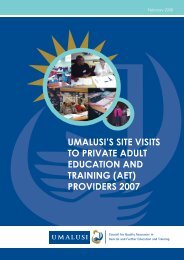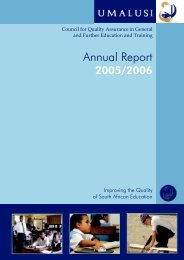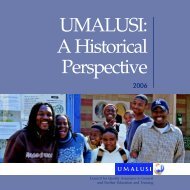Inspecting the Foundations - Umalusi
Inspecting the Foundations - Umalusi
Inspecting the Foundations - Umalusi
Create successful ePaper yourself
Turn your PDF publications into a flip-book with our unique Google optimized e-Paper software.
some offer FET subjects only. Numbers attending individual PALCs vary from two to over 2 000learners. At least fi ve PALCs (those with numbers of learners between 50 and 2 000, and offering<strong>the</strong> full range of GETC learning areas) in each province were <strong>the</strong>n re-contacted and asked aboutwhich curriculum documents <strong>the</strong>y were using. Attempts were made to obtain learning programmesdeveloped by <strong>the</strong> PALCs <strong>the</strong>mselves.It is worth noting that when trying to obtain ABET curriculum documents, <strong>the</strong>re were diffi cultiesat national, provincial, and local levels. Not all national offi cials had copies of <strong>the</strong> nationaldocuments. Provincial offi cials within single ABET directorates gave differing information, and werenot always sure of <strong>the</strong> exact titles, dates, and availability of documents. It appears that local adulteducators are using a variety of materials, and that <strong>the</strong>se are not always what <strong>the</strong>ir provinces haveprovided or intended to provide.In addition, <strong>the</strong>re is considerable development of curriculum material: <strong>the</strong> National DoE upgradesand circulates draft documents from time to time; SAQA periodically updates and circulates unitstandards; some provinces develop extensive documentation around <strong>the</strong> interpretation of unitstandards and <strong>the</strong> development of learning programmes; many PALCs develop <strong>the</strong>ir own learningprogrammes.To sum up <strong>the</strong>n, it was diffi cult to fi nd consensus regarding <strong>the</strong> ABET documents in use within andacross provincial departments and <strong>the</strong>ir respective PALCs. It was also extremely diffi cult to get holdof copies of <strong>the</strong> documents which offi cials cited as being in use.Documents from private providers who offer <strong>the</strong> national GETC: ABETA list of private ABET providers was obtained from <strong>the</strong> IEB, and <strong>the</strong> managing directors of ten of<strong>the</strong> largest of <strong>the</strong>se were interviewed telephonically about <strong>the</strong>ir ABET curriculum-developmentprocesses and documents. It emerged that <strong>the</strong>se providers develop course outlines and overviewsra<strong>the</strong>r than learning programmes. A diffi culty here was that, while <strong>the</strong> directors of <strong>the</strong> institutionswere happy to name <strong>the</strong>ir documents and describe <strong>the</strong>ir processes telephonically, some wantedconfi dentiality regarding what were actually <strong>the</strong>ir trade secrets – not confi dentiality of <strong>the</strong>ir identity,but confi dentiality with respect to <strong>the</strong> actual information.As with <strong>the</strong> public institutions, providers were asked additional questions as it was thought that<strong>the</strong> information might provide important contextual background for <strong>the</strong> next part of <strong>the</strong> study.Directors were asked about <strong>the</strong> numbers of adult learners doing <strong>the</strong>ir courses, and <strong>the</strong> costs ofcourses (a summary of <strong>the</strong> courses offered by nine large ABET providers registered with <strong>the</strong> IEBand <strong>the</strong>ir curriculum development processes, number of learners and costs, can be accessed onwww.umalusi.org.za/<strong>Inspecting</strong><strong>the</strong>foundations/Appendix 4. The names of <strong>the</strong> providers have beenwithheld.)Curricula for enrichment and ad hoc coursesCurricula for what have been described here as enrichment and ad hoc courses were notspecifi cally sought in <strong>the</strong>ir own right, but were discovered in <strong>the</strong> process of looking for GETCdocuments. These curricula were for courses offered at PALCs and by private institutions offering<strong>the</strong> GETC courses (using <strong>the</strong> IEB as <strong>the</strong>ir assessment body). The enrichment courses appear to bedesigned to cover selected unit standards, such as those pertaining to <strong>the</strong> arts, and potentially tofacilitate individual entrepreneurial activity.It also emerged that <strong>the</strong>re were ad hoc courses developed to meet <strong>the</strong> needs of large clients suchas private businesses and parastatal institutions, for groups of adult learners in <strong>the</strong>ir employ. Thesecourses, also based on unit standards, are specifi cally customized to fi t <strong>the</strong> needs of <strong>the</strong> particularclients. Attempts were made to obtain documentation for some of <strong>the</strong>se courses, but few providerswere willing to submit <strong>the</strong>ir material.17


